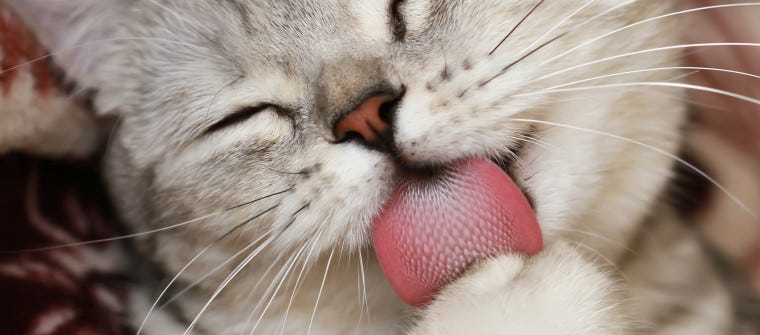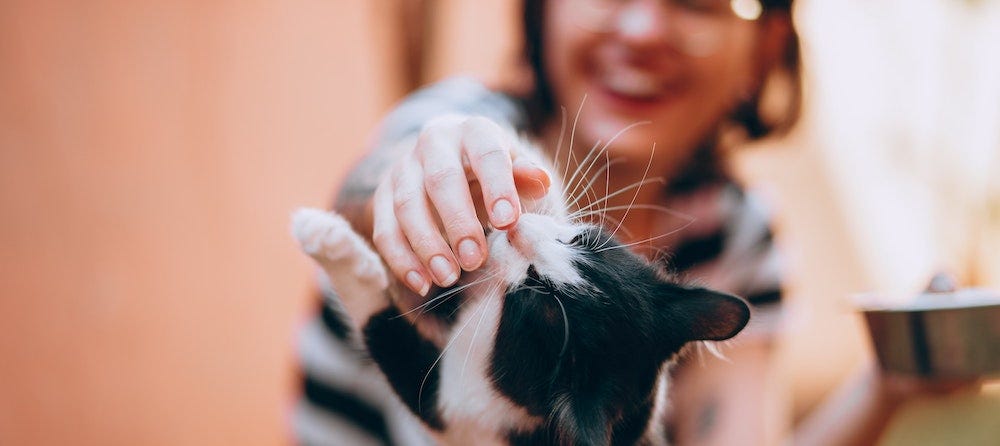Have you ever noticed your cat chewing and licking something other than his food, fur, or toys? This puzzling behavior may indicate that he has a compulsive eating disorder called pica. Pica in cats is surprisingly common—and potentially dangerous. Learn to look for signs of pica and find out how you may be able to treat the disorder in your cat.
What is pica?
Pica is an obsessive-compulsive disorder characterized by the persistent consumption of nonfood items. Many species, including humans, can have pica. Pregnant women and young children are more likely to suffer strange cravings for non-nutritional items like dirt, chalk, and even soap. Did you ever eat Play-Doh as a kid? You probably had pica.
What causes pica in cats?
Veterinarians and feline behaviorists suggest that pica is more common among certain cats.
Weaned too young
The younger a cat is weaned, the stronger his drive is to nurse—and the more likely he is to suck on wool, fleece, or other fuzzy items. This “wool-sucking” compulsion may lead to more dramatic behavior like ingestion.
Genetic predisposition
Breeds including Siamese, Oriental Shorthair, Burmese, and Birman are more likely to carry the gene that is linked to pica.
Dietary deficiencies
Cats that are lacking fiber or fat in their diets may be more likely to exhibit signs of pica, such as chewing on plants. Cats with anemia are more likely to consume cat litter.
Underlying medical issues
Pica in cats is sometimes associated with FIV or FeLV. Conditions like diabetes, dental disease, hyperthyroidism, or brain tumors may also trigger the disorder.
Boredom
A cat lacking physical or mental stimulation may be more likely to partake in devious behaviors. Call it a cry for attention, if you will
Signs of pica in cats
In addition to wool, you may notice your cat licking, sucking, chewing, and/or eating common household items such as:
- Plastic bags or shower curtains
- Soft fabrics like blankets, curtains, or clothes
- Paper, paper towel, or toilet paper
- Houseplants (a top poison among domestic cats)
- Hair (human or otherwise)
- Shoelaces
- Rubber bands
- Electrical cords
- Litter
It’s easy to see how pica in cats might become a dangerous compulsion. Ingesting nonfood items can lead to poisoning, asphyxiation, intestinal blockage, and death.
How to treat pica in cats
Your cat’s occasional licking or chewing on household items may not warrant concern. However, if you notice your cat attempting to eat nonfood items or houseplants, you should take measures to prevent this behavior in the future.
Visit the vet
It’s a good idea to first rule out any underlying medical issues in your cat. Make an appointment with your veterinarian to discuss your cat’s symptoms and current diet. The vet will probably give your cat a physical examination and run blood work.
Provide chewable alternatives
Growing cat grass or an indoor herb garden may satisfy your kitty’s urge to snack on inappropriate items. You can also supply him with catnip-laced toys and puzzle feeders.
Supplement your cat’s diet
Ask your vet about adding fiber supplements to your cat’s diet. Cat grass is also a good source of fiber—just be sure to supervise his grazing habits, or he may end up with an upset stomach.
Hide or remove household temptations
First, get rid of dangerous household plants. These include (but are not limited to) lilies, foxglove, philodendron, azalea and rhododendron, cyclamen, oleander, sago palm, castor bean, yew, and marijuana plants. Keep plastic bags out of reach (or better yet, switch to paper!) and don’t leave small items like rubber bands lying around.
Make items unappealing
Apply strong-smelling substances like citrus or lavender sprays to items you can’t hide or remove, such as electrical cords. Some people find success with applying foul-tasting substances like Bitter Apple, as well.
Play with your cat
Give your cat interactive playtime for at least 15 minutes a day, using toys designed like a fishing pole so you can simulate the movements of prey. When he’s alone, provide him with physical stimulation (catnip toys, puzzle feeders, cat trees, scratching posts, etc.) and mental stimulation (a window perch with a clear view of nature so he can distract himself by observing birds, squirrels, and the occasional neighborhood cat).
It’s important to recognize pica in cats before a trip to the emergency vet is required. Keep these tips in mind—you’ll most likely find that this feline disorder is easily treatable!
Sources:









